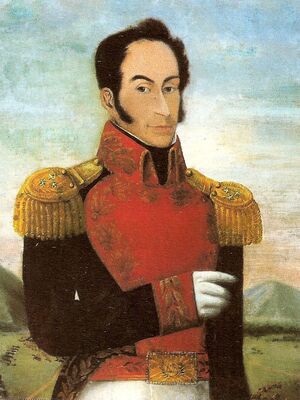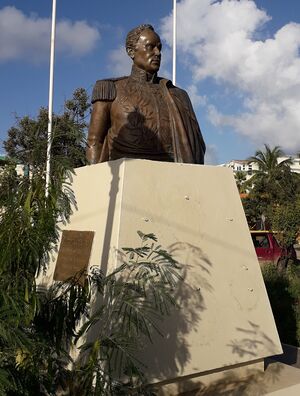Biography
| Simón Bolívar has Latin American ancestry. Join: Latin American Roots Project Discuss: latin_america |
Simón José Antonio de la Santísima Trinidad Bolívar y Palacios Ponte y Blanco, commonly known as Simón Bolívar, was a Venezuelan military and political leader. Bolívar played a key role in Latin America's successful struggle for independence from the Spanish Empire, and is today considered one of the most influential politicians in the history of the Americas.
Simón Bolívar was born 24 July 1783, in Caracas, Venezuela. He was baptized, 30 July 1783, Simón José Antonio de la Santísima Trinidad Bolívar, the fourth child of Juan Vicente Bolívar and María de la Concepción Palacios y Sojo.[1].[2]
30 Jul 1783, Caracas, Distrito Federal, Venezuela. Partida de bautismo de Simón Bolívar.
En la ciudad Mariana de Caracas, en 30 de julio de 1783 años, el Doctor Don Juan Felix Jerez y Aristeguieta, presbítero, con licencia que yo el infrascripto Teniente Cura de esta Santa Yglesia Catedral le concedí, bautizó, puso óleo y crisma y dio bendiciones a Simón José Antonio de la Santísima Trinidad, párvulo, que nació el veinte y cuatro del corriente, hijo legítimo de Don Juan Vicente de Bolívar y de Doña María de la Concepción Palacios y Sojo, naturales y vecinos de esta ciudad. Fue su padrino Don Feliciano Palacios y Sojo, a quien se advirtió el parentesco espiritual y obligación; y para que conste lo firmo. Fecha ut supra.
Bachiller Manuel Antonio Faxardo
Simón had a brother and two sisters. His parents were affluent, high born, natives of Caracas. Sadly, Simón's father died in 1786 and his mother in 1789.[3]
His guardian Carlos Palacios, saw that he obtained a good education and at the age of 14 or 15 he was sent to Spain to complete his education.[3]
In Madrid, he met Teresa, daughter of Bernardo Rodriquez del Toro and Benita Alayza, but a marriage was postponed because of the couple's young age. Simón was only 17, and Teresa was three years younger.[3][2] Simón subsequently spent a couple of years in Paris living in the Palais Royal, where at least one biographer implies that his main occupation was enjoying himself.[3]
In 1802, he returned to Madrid and married Teresa. The couple returned to Caracas, but their happiness was short-lived for Teresa died 22 January 1803, leaving no offspring.[3]
Bolívar later said:
I loved my wife much, and at her death I took an oath never more to marry. ... If I had not been bereaved, perhaps my life would have been different;... The death of my wife placed me early in the road of politics, and caused me to follow the chariot of Mars instead of the plow of Ceres.
In 1804, Bolívar returned to Europe, where he read and studied and further honed his own philosophy. A German scientist, Alexander von Humboldt, told him that he believed the Spanish colonies were ripe for independence. The idea became rooted in his mind and on the heights of Monte Sacro, in Rome, Bolívar vowed to liberate his country.[4]
Bolívar returned to Venezuela in 1807 and the Latin American independence movement began the next year. The Spanish governor was removed from office. A junta (a committee or administrative council) took over. Bolívar was sent to London to gain recognition and aid for the new government. He failed in this but persuaded Francisco de Miranda to return to Caracas and take command of the independence movement. Francisco had made an earlier attempt to liberate his country. The country declared its independence July 5, 1811, and Bolívar entered the army of the new republic. One of his officers, in a treasonable action, opened the fortress of Puerto Cabello to the Spanish army. Control was lost and an armistice was signed July 1812, leaving the country back in the hands of Spain. Bolívar and others prevented the escape of Miranda, who then spent the rest of his life in Spanish dungeons.[4]
Bolívar was determined to continue the effort. He traveled to New Granada, and with the aid of New Granada led a force to retake Venezuela. After six hard-fought battles he entered Caracas on Aug 6, 1813. He was given the title of Liberator and became the political dictator of Venezuela. A civil war broke out. The Spanish once again defeated Bolívar, who fled to New Granada. There he was commissioned to and succeeded in removing a separatist faction from Bogotá (now in Colombia). An attempt to lay siege to Cartagena failed and once again Bolívar fled, this time to Jamaica.[4]
Three years of defeats and victories followed. Bolívar designed an incredibly daring move to attack the Viceroyalty of New Granada. The Spaniards were surprised because Bolívar’s army approached from the Andes Mountains, where no one expected them to be, after a seven day march. This bold action was a turning point in South America’s history.[4]
A new republic was formed: Gran Colombia (now the countries of Colombia, Panama, Venezuela and Ecuador.[4]
Nov 1820 a six-month peace treaty was signed.[4]
June 1821 The Battle of Carabobo opened the gates of Caracas. Venezuela was free.[4]
May 1822, Bolívar won a victory that freed Ecuador from the Spanish.[4]
During his time in Ecuador, he met Manuela Sáenz, who became his mistress. She was an ardent revolutionary. She saved him from conspirators in 1828. After his death she was exiled from Bogotá and died during a diptheria epidemic in Peru in 1856.[5]
1824 Liberation of Peru, through the actions and direction of Bolívar[4]
1825 Upper Peru fell to the liberating army. The new country of Bolivia was formed.[4]
Bolívar had plans to unite South America, but the individual countries even within Gran Columbia began to oppose each other. After several years of disruption, Venezuela seceded from Gran Colombia.[4]
Bolívar left Bogotá intending to return to Europe. He died December 17, 1830, near Santa Marta, Colombia.[4]
For more details on the life of Simón Bolívar, see any of the sources listed below.
Legacy
The country of Bolivia is named in Bolivar's honor, as is Bolivar County, Mississippi and numerous other events, monuments and places.
Sources
- ↑ Venezuela, registros parroquiales y diocesanos, 1577-1995 - FamilySearch - Caracas - El Sagrario > Bautismos 1689-1790 image 2838/2966 Parroquias Católicas, Venezuela
- ↑ 2.0 2.1 Holstein, Henri La Fayette Villaume Ducoudray Memoirs of Simon Bolivar: President Liberator of the Republic of Colombia, and of his principal generals : secret history of the Revolution and the events which preceded it, from 1807 to the present time : with an introduction containing an account of the statistics and the present situation of said Republic, education, character, manners and customs of the inhabitants. Boston: S. G. Goodrich, 1830.
- ↑ 3.0 3.1 3.2 3.3 3.4 Larrazábal, Felipe. The life of Simon Bolivar: liberator of Colombia and Peru, father and founder of Bolivia... New York: Edward O. Jenkins, 1866.
- ↑ 4.00 4.01 4.02 4.03 4.04 4.05 4.06 4.07 4.08 4.09 4.10 4.11 Encyclopædia Britannica Online, s. v. "Simon Bolivar", accessed February 14, 2016,
- ↑ “Manuela Sáenz” Encyclopedia Britannica online.
See also:
- Lynch, John. Simón Bolívar: A Life. Yale University Press, 2007. (recommended)
- Simón Bolívar: Venezuelan soldier and statesman at Britannica
- Smith Scott S. Simon Bolivar: Liberator of Latin America at militaryheritage.com
- Simon Bolivar and the Spanish Revolutions at Historytoday
- Simón Bolívar at Wikipedia
- Cloud Biography at YouTube Simón Bolívar. Less than 2 minutes.
- Holstein, Henri La Fayette Villaume Ducoudray Memoirs of Simon Bolivar: President Liberator of the Republic of Colombia, and of his principal generals : secret history of the Revolution and the events which preceded it, from 1807 to the present time : with an introduction containing an account of the statistics and the present situation of said Republic, education, character, manners and customs of the inhabitants. Boston: S. G. Goodrich, 1830.
- Larrazábal, Felipe. The life of Simon Bolivar: liberator of Colombia and Peru, father and founder of Bolivia... New York: Edward O. Jenkins, 1866.
- Encylopedia of Exploration 1800-1850, Howgego
No known carriers of Simón's ancestors' DNA have taken a DNA test. Have you taken a test? If so, login to add it. If not, see our friends at Ancestry DNA.
Featured Eurovision connections: Simón is 36 degrees from Agnetha Fältskog, 33 degrees from Anni-Frid Synni Reuß, 34 degrees from Corry Brokken, 29 degrees from Céline Dion, 32 degrees from Françoise Dorin, 34 degrees from France Gall, 37 degrees from Lulu Kennedy-Cairns, 35 degrees from Lill-Babs Svensson, 27 degrees from Olivia Newton-John, 41 degrees from Henriette Nanette Paërl, 39 degrees from Annie Schmidt and 23 degrees from Moira Kennedy on our single family tree. Login to see how you relate to 33 million family members.
B > Bolívar | B > Bolívar y Palacios Ponte y Blanco > Simón José Antonio de la Santísima Trinidad (Bolívar) Bolívar y Palacios Ponte y Blanco
Categories: Collaborative Profile of the Week | Namesakes US Counties | Venezuelan Politicians | Example Profiles of the Week | Featured Connections Archive 2022 | Persons Appearing on US Postage Stamps | Latin American Roots | Venezuela, Notables | Notables







I live in Bolivar, Missouri and our school teams are the Bolivar Liberators for Simon. On our courthouse lawn is a statue of Simon. Here is an article about him & a picture of the statue. https://bolivarchamber.com/about/history/ Here is a better picture: https://www.flickr.com/photos/courthouselover/30551194705 Statue dedication (I hear it was a big deal in our little town) with Harry S. Truman & Venezuelan President Romulo Gallegos in 1948. https://www.nbcnews.com/news/latino/hispanic-heartland-bolivar-missouri-where-two-continents-met-n286016
We are featuring this profile in the Connection Finder this week. Between now and Wednesday is a good time to take a look at the sources and biography to see if there are updates and improvements that need made, especially those that will bring it up to WikiTree Style Guide standards. We know it's short notice, so don't fret too much. Just do what you can.
Thanks!
Abby